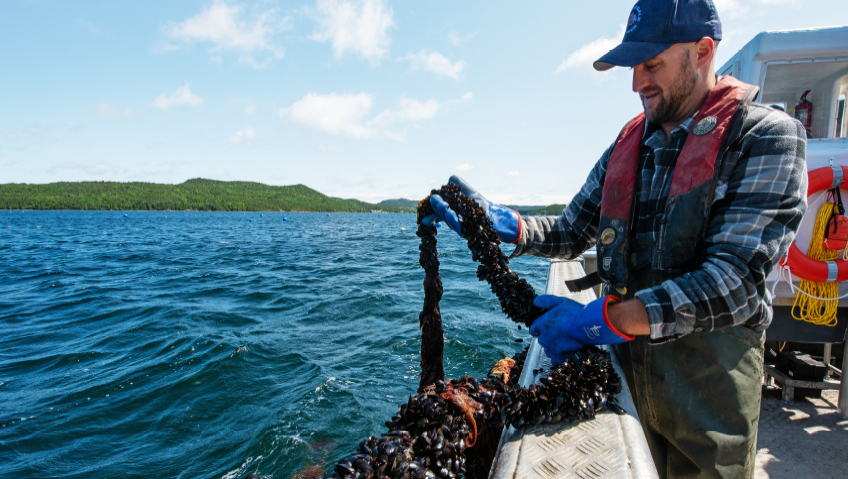In this feature we look at how aquaculture has revitalized Newfoundland’s economy and at the same time is addressing global issues of food security while, through near net-zero carbon emissions, the industry is doing its bit to help stem climate change.
Newfoundland and Labrador’s economy had been based on fishing the rich North Atlantic ever since John Cabot arrived in 1497, leading an influx of European fishermen from England, France, Holland, Portugal, and Spain, who began establishing permanent settlements in 1603.
And so it continued in a sustainable manner for centuries until the 1950s, when the arrival of enormous, technologically advanced trawlers, many from Europe and Russia, began depleting not only the cod stock but severely damaging the ocean ecosystem that the remaining fish needed to survive.
Following 40 years of myriad contributing factors, including the rapid growth of the seal population – natural predators of fish – the northern cod fishery collapsed in the early 1990s and the federal Department of Fisheries and Oceans imposed a moratorium on July 2, 1992, ending 500 years of commercial fishing and a cod stock that had lasted for millennia.
It was the largest industry shutdown ever in Canada. As a result, over 37,000 fishermen and fish plant workers lost their jobs, leaving over 400 coastal communities devastated.
Not only did the collapse of the fishery have a severe socioeconomic impact on the entire province, it raised troubling questions about food security.
Fish are recognized as an excellent source of protein and essential omega-3 fatty acids, and are high in certain vitamins and minerals, including Vitamin B-6 and 12, potassium, iodine, magnesium, and potassium.
However, just as demands for this healthy protein source increased, the supply dwindled and almost disappeared. The effect was all the more shocking because this priceless resource had once been deemed inexhaustible.
Aquaculture to the rescue
When the fishery collapsed and the cod moratorium was legislated in 1992, aquaculture was a fledgling industry in Newfoundland. Today, with a market value of over $276 million, it is an economic success story that provides more than 2,500 jobs, over 90 percent of which are full time. Aquaculture is a key part of economic development and the diversification of Newfoundland’s economy.
Within the industry is a wide range of jobs – in the hatcheries, farms and processing plants, and including positions for skilled engineers, veterinarians, researchers, marine biologists, scientists, and farmers. In addition, there are many indirect jobs, in feed manufacturing, packaging, supplies and service, vessel repair and maintenance, and transportation.
To learn more we spoke with Mark Lane, Executive Director of the Newfoundland Aquaculture Industry Association (NAIA) and the mayors of three coastal communities, Stephenville, Harbour Breton and Hermitage-Sandyville.
Lane tells us that the NAIA, which was formed 30 years ago, initially represented the interests of hundreds of farmers, but since then there has been a lot of consolidation. Membership now includes businesses on the service supply chain, coastal communities, and seven major aquaculture companies.
Among them are three of the world’s largest: Cooke Aquaculture, a family-owned company based in Blacks Harbour, New Brunswick, Canada, and two publicly traded companies, Mowi Canada International and Grieg NL Seafarms Ltd, both of which originated in Norway.
The industry is divided into two sectors. The larger salmonid sector produces Atlantic salmon, steelhead trout, and Atlantic cod, while the smaller shellfish sector produces mainly blue mussels, some of which are certified organic, along with oysters and sea urchins.
“We are really proud of what we’re doing,” Lane says. “The aquaculture industry in Newfoundland, with seventeen thousand kilometers of coastline, surrounded by pristine waters and proximity to the US market, has an enormous potential to give hardworking Newfoundlanders an opportunity to work at home.”
Socio-economic impact
Steve Crewe, Mayor of Hermitage-Sandyville, a small community (pop 422) on Newfoundland’s south coast, succinctly describes the region’s dependence on the industry: “We don’t exist without aquaculture. Without it we would be an aging, dying coast, but with it we are booming.”
He says that prior to 2008, when aquaculture got started in Hermitage-Sandyville, the community had a small fish plant that operated about 14 weeks a year and most people earned approximately $20,000. “Now everyone is working, and most people earn around $50,000, and we’ve never seen that before.”
The fish farming process begins in one of a number of land-based hatcheries where the eggs are produced and raised to the smolt stage over a period of 18 months before they are transported to licensed off-shore fish cages.
Water systems
We spoke with Tom Rose, Mayor of Stephenville on the west coast, (with a catchment area of 25,000) about the Northern Harvest Sea Farms hatchery operation located there, adjacent to the town’s international deep seaport facility and airport. He told us that since being purchased by Mowi, it is gearing up for significant multi-million dollar enhancements.
The hatchery in Stephenville, one of the largest in North America, is strategically located to take advantage of what Rose calls “one of the best water systems in Canada. We are blessed here in Stephenville to have deep artesian wells for our water system and we have deep rivers in our aquifers running down to the salmon hatchery and that was one of the reasons we were selected.
“One of the things I like about it is that there are no emissions coming from this facility. We had a pulp and paper mill that closed down years ago and we lost up to 250 jobs, but we also lost the smokestacks, and today Stephenville is a cleaner, greener town,” Rose says. So clean that the town has been able to sign on as a partner with a federal climate protection program that reduces greenhouse gas emissions and allows the town to accrue carbon credits.
Embraced by nature
Aquaculture fits right in with Stephenville’s master plan, the tagline of which is ‘Embraced by Nature,’ and which has three major checkpoints, the economy, social development, and the green component. “The aquaculture industry does not have a heavy footprint, and really ties into our strategic plan as the type of industry we want to expand for the future of our community,” says Rose.
The environmental benefits are echoed by Lane, who talked about the marine cages which then allow the salmon smolts to grow in their natural environment and how the farms are operated vertically as opposed to laterally, thereby creating a minuscule footprint. “To produce 18 billion meals of salmon last year, globally we used .00008 percent of the world’s ocean,” he says, to illustrate just how efficiently and environmentally friendly it is to produce a huge output of food for a planet with a population of seven billion people and still growing.
Aquaculture, he maintains, is the future of food. “When you compare traditional agriculture, the beef cattle industry, with aquaculture in terms of carbon footprint, water usage and food conversion ratio, we’ve far out-performed any other type of animal protein farming.”
Adds Rose, “If you are a true environmentalist, you have to support aquaculture as it is the only way we are going to feed the planet without destroying it.”
Cod disaster
Meanwhile, Georgina Ollerhead, Mayor of Harbour Breton (pop 1,634) on Fortune Bay on the island’s south coast, speaks about what aquaculture means to her community. “When I talk about it, I say to people, where would the entire coastal area be without it?
“When the cod disaster happened in the early nineties we depended on the fish plant and it closed. We had people packing up and leaving, moving out west to look for work, others not willing to move but having no work. When aquaculture came it was a blessing to us and it has been ever since.”
With people working year-round at good paying jobs, she says the tax base of the small town is able to maintain a hospital, ambulance service, a fitness centre, municipal infrastructure, as well as retail.
Lane recalls the massive impact the cod moratorium had on every rural outport, with Harbour Breton and Hermitage especially badly impacted. He recalls that at the time he was working for a newspaper, was in Harbour Breton the day the plant closed, and there the day it reopened to process salmon. “To see people going back to work was emotional and impactful.”
Turning the tide
But it’s not only about people going back to work, it is about also stemming the out-migration tide which has plagued Newfoundland for years. Ollerhead notes her amazement at how technical the plants are, and how young people who graduate from Memorial University in St. John’s are able to find work in their home communities.
In keeping with that, Lane says NAIA has taken the initiative to launch Aquaculture 101, a comprehensive internet-based resource that teachers can download and use to provide for their students a virtual reality tour of shellfish and fish farming. With this technology the association will be able to show high school students the amazing opportunities that await them.













